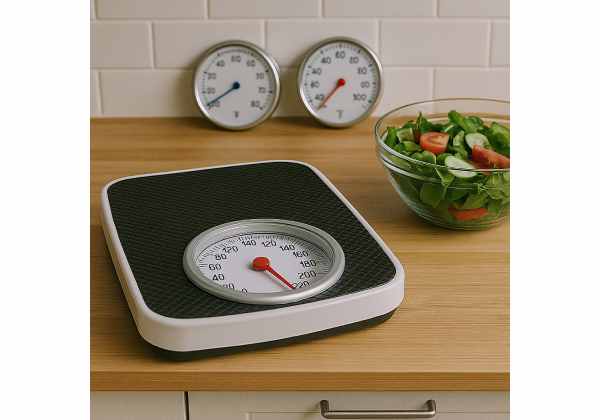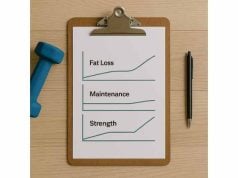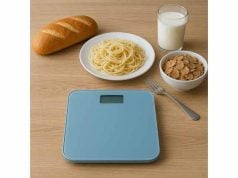
Your body is not a thermostat locked to one number on the scale. Weight regulation is dynamic: hormones, appetite signals, energy expenditure, sleep, activity, and food environment interact to produce a “settling” range. During dieting, adaptive thermogenesis changes how many calories you burn, often more than you expect, and it can stall fat loss even when you think you have the math right. This guide explains what set point and adaptive thermogenesis really are, what they are not, and how to work with—rather than against—your physiology. If you are troubleshooting a stubborn plateau or shifting into maintenance, you may also find the step-by-step support in our plateau and maintenance troubleshooting especially useful.
Table of Contents
- What set point really means
- Adaptive thermogenesis explained
- Does your body fight weight loss?
- How to lower your set range
- Diet breaks and refeeds that help
- Movement and NEAT during dieting
- Troubleshooting true plateaus
- Frequently Asked Questions
What set point really means
“Set point” is a helpful shorthand, but it is not a single fixed number. What most people experience is better described as a set range—a band of body weights where appetite, movement, and metabolism tend to keep you. The width of that band varies. For some, it may be narrow (a few pounds up or down). For others, it’s wider and influenced by routines, sleep, stress, and food environment.
Two ideas make set point confusing:
- Biology adapts; behavior adapts. Hormones such as leptin, ghrelin, and peptide YY respond to energy intake, fat mass, and sleep. But your day-to-day movement, food choices, and planning also shift with your goals and environment. Both layers are real.
- History matters. Months or years at a higher weight build strong habits and neural expectations around portion sizes, reward, and convenience. Those learned patterns feel like “my body wants this weight,” but much of it is memory and routine.
What it is not:
- A destiny. You are not biologically locked into one weight forever.
- A universal number. Genetics affect susceptibility to weight gain and ease of weight loss, but two people with similar genes can settle at very different weights depending on lifestyle and environment.
Think of your set range like a hammock between two trees: the trees are genetics and physiology; the sag and sway are sleep, stress, diet, movement, and the environments where you spend time (home, workplace, social circles). To move the hammock, you either shift the trees a little (long-term biological signals) or you change the anchors and ropes (habits, food environment, daily activity). In practice, that means:
- Longer maintenance phases at a new lower weight help your brain and appetite signals recalibrate.
- Resistance training preserves muscle and raises the ceiling for energy flux—how much you can eat while maintaining.
- High-protein, high-fiber patterns reduce hunger and help keep the new range comfortable.
A practical way to evaluate your current set range is to observe your weight trend and hunger over 6–12 weeks during maintenance. If your weight holds within a two- to three-pound band with stable hunger and energy, you have a good read on your current maintenance zone. If you are new to these concepts, a quick primer on basics lives in our weight loss guide.
Adaptive thermogenesis explained
Adaptive thermogenesis is the drop in total daily energy expenditure that exceeds what we would predict from weight loss alone. Lose weight, and you should burn fewer calories because a smaller body costs less to move. Adaptive thermogenesis is the extra reduction—your body getting thrifty.
Where the drop comes from:
- Resting energy expenditure (REE). The calories you burn at rest often decline more than predicted. For many dieters this is modest, but aggressive or prolonged deficits can make it larger.
- NEAT (non-exercise activity thermogenesis). Fidgeting, posture changes, pacing, standing—these movements quietly account for hundreds of calories in some people. NEAT is the most variable component and frequently falls during dieting without you noticing.
- Thermic effect of food (TEF). Eating less reduces the energy cost of digestion. Lower carb and fat intakes cut TEF; protein has a higher TEF, which is one reason higher-protein diets can help.
- Exercise efficiency. You become more economical: the same run or lift session costs slightly fewer calories.
How big is adaptive thermogenesis? Average estimates vary widely, but reductions of roughly 3–15% of total daily expenditure beyond body-size changes are common, with outliers on both ends. The range depends on deficit size, diet duration, sleep, stress, training style, and genetics. This is why two people following the same plan can see different outcomes.
Signals you might be experiencing adaptation:
- Your daily steps drift down without planning.
- Workouts feel heavier; you unconsciously reduce intensity or volume.
- Hunger ramps up while satiety from the same meals drops.
- Resting heart rate falls more than expected, and you feel colder.
What helps:
- Protein at 1.6–2.2 g/kg of goal body weight supports lean mass and slightly higher TEF.
- Three to five resistance sessions weekly preserve or build lean mass, which defends REE.
- Purposeful NEAT targets (e.g., +2,000 steps over baseline) replace the incidental activity that often disappears.
- Diet breaks and refeed strategies (covered below) can reduce fatigue, improve training quality, and maintain sanity, even if their metabolic effects are modest.
- Sleep 7–9 hours and manage stress; sleep debt heightens hunger and reduces spontaneous activity. For a deeper dive on recovery’s role during dieting, see our piece on sleep and stalled fat loss.
The bottom line: adaptive thermogenesis is real, but not unbeatable. It is better to expect it, plan for it, and build systems that maintain movement, muscle, and meal quality during a cut than to hope it will not happen.
Does your body fight weight loss?
Yes—and no. Your body defends against energy deficits because, historically, famine was a bigger threat than abundance. Appetite increases, and energy expenditure drifts down. But the extent of “defense” varies, and people can and do lose fat sustainably. The key is separating myths from facts and then adjusting the plan.
Common myths
- “I have a fixed set point; my body always bounces back.” In reality, your set range can shift when your environment and habits change for long enough.
- “My metabolism is broken.” Metabolisms adapt; they are rarely broken. Meaningful slowdowns are usually explained by reduced NEAT, less lean mass, and smaller body size.
- “Nothing works at my age.” Hormonal shifts (e.g., perimenopause) can change symptom patterns and hunger, but progress remains possible with smarter pacing and recovery.
Facts to ground your plan
- Energy compensation is normal. Expect some drop in expenditure beyond weight change and account for it.
- Hunger is information. Persistent, intense hunger signals your food environment, protein/fiber intake, sleep, and deficit size may need tuning.
- Medication and medical conditions matter. Some prescriptions increase appetite or fluid retention; others alter energy expenditure. If your weight stalls despite consistent adherence, review medications with your clinician. See our guide to medications linked to plateaus for a structured conversation checklist.
What to do about it
- Choose a moderate rate of loss. Target about 0.5–1.0% of body weight per week. Faster cuts increase fatigue and adaptation without improving long-term outcomes.
- Front-load protein and produce. Anchor meals around lean protein (25–40 g per meal) and 1–2 cups of vegetables or fruit. This improves satiety per calorie.
- Build friction against overeating. Keep trigger foods out of sight or out of the house during the cut. Pre-portion snacks. Eat seated, without screens.
- Schedule maintenance phases. Plan 2–8 weeks at calculated maintenance after every 8–16 weeks of dieting. This is not “giving up”; it is how you consolidate progress.
- Audit movement honestly. Track steps and weekly training volume. When weight loss slows, check whether movement slipped before cutting more calories.
The story is less “my body is fighting me” and more “my body is adapting; I can adapt my plan in return.” Most plateaus resolve when you address NEAT, protein/fiber, sleep, and deficit size together rather than chasing a single lever.
How to lower your set range
Lowering your long-term settling range is a slow, deliberate process. You are teaching your brain and body that the new weight is normal, safe, and sustainable. The tools are simple, but they work only when you give them time.
1) Periodize the year
- Cut phases: 8–16 weeks, moderate deficit.
- Maintenance phases: 4–12 weeks, deliberate practice of maintenance skills.
- Strength emphasis blocks: prioritize progressive overload, sleep, and higher-calorie days to support muscle.
A yearly rhythm of loss, maintenance, and strength is one of the most reliable ways to “lock in” a lower range.
2) Practice maintenance like a skill
- Establish a weekly check-in: average weight, waist, steps, training, and a short note on hunger/energy. Look for stability, not perfection.
- Create guardrails: a high-end weight boundary (e.g., +2–3 lb). If you cross it for two weeks, follow your prewritten action plan: tighten meal structure, rebuild step targets, and reduce alcohol.
3) Build an environment that prefers maintenance
- Keep staple proteins, frozen vegetables, and high-fiber carbs stocked.
- Standardize two breakfasts and two lunches you can execute when busy.
- Use smaller plates, pre-plate servings, and keep tempting foods inconvenient.
4) Preserve or build muscle
- Lift 3–4 times per week, focusing on compound patterns (squat, hinge, push, pull) and progressive overload.
- Hit ~10–20 hard sets per major muscle per week depending on experience.
- Keep protein high and distribute it across meals.
5) Consider a gentle reverse
After a successful cut, some people benefit from a gradual calorie increase to maintenance while holding weight steady—useful if hunger remains high or training quality lags. If you prefer structure, see our guide to a practical, non-mythy version of this in reverse dieting.
Lowering your set range is ultimately about time at maintenance with strong habits, not about chasing hacks. The longer you live well at the new weight, the easier it becomes to keep.
Diet breaks and refeeds that help
Diet breaks and refeeds are tools, not magic. Used well, they improve adherence, training, mood, and social flexibility. Used poorly, they become unplanned free-for-alls that erase your deficit.
Definitions
- Refeed: 1–2 days at calculated maintenance, mainly via carbohydrates, while protein stays high and fat stays moderate.
- Diet break: 1–2+ weeks at maintenance calories with normal training and step targets.
What they do well
- Reduce fatigue and make workouts more productive.
- Practice maintenance behaviors without abandoning the overall plan.
- Offer social flexibility for events and travel.
What they do not do
- “Reset” metabolism permanently.
- Guarantee faster fat loss.
How to implement
- Refeeds during hard training blocks. Place them on your most demanding training days to support volume and performance. Keep structure: prelog meals, prioritize high-fiber carbs, and avoid trigger foods.
- Diet breaks every 8–12 weeks of cutting. Spend at least 2 weeks at a calculated maintenance based on current body weight and activity. Maintain protein and steps; keep the same meal structure.
- Measure the outcomes. Track mood, sleep, training volume, and weight trend. If you return from a break with better adherence and stable weight, it worked.
For a deeper comparison of when to use each tool, visit our focused guide on refeeds versus diet breaks.
Movement and NEAT during dieting
NEAT is often the silent reason a deficit disappears. When calories drop, spontaneous movement tends to fall: fewer posture changes, less fidgeting, more sitting. Because NEAT can vary by several hundred calories between people—and day to day within the same person—planning it matters.
Build a NEAT floor
- Set a baseline from two weeks of normal life. If you average 6,500 steps, your floor might be 6,000.
- Add a target increment during the cut: +2,000 steps over your baseline on most days.
- Use environmental prompts: standing desk blocks, “walk the first 10 minutes of every call,” park at the far end, carry groceries one bag at a time.
Lift to protect lean mass
- Three to five sessions per week.
- Prioritize compound lifts and progressive overload.
- Keep sessions focused; limit junk volume.
Cardio with intention
- Choose modes you enjoy (brisk walking, cycling, rowing).
- Anchor two to four 20–40 minute sessions weekly, or equivalent via active commuting.
- Avoid turning cardio into a license to overeat; keep food structure steady.
Why this works
- NEAT stays elevated instead of drifting down.
- Lifting defends REE and gives shape to the loss.
- Cardio improves work capacity, mood, and sleep quality.
If your steps and training consistently drop during a cut, fat loss slows even when your food tracking is accurate. A simple plan for daily movement removes that hidden variable. For practical strategies specific to dieting, see our article on preventing NEAT drops.
Troubleshooting true plateaus
Before changing calories, confirm whether you are in a true plateau. Water, sodium, glycogen, menstrual cycle, and constipation can hide fat loss for 1–3 weeks even when your plan is working. Use a structured check:
1) Verify the stall
- Daily weigh-ins, weekly averages. Compare week-over-week averages for 2–4 weeks.
- Waist and hips weekly at the same time of day.
- Photos and clothes fit every two weeks.
If your weight trend is flat and measurements do not change over 2–4 weeks, troubleshoot.
2) Audit the inputs
- Food accuracy. Weigh or pre-portion calorie-dense items (oils, nut butters, snacks). Spot-check a week with a food scale.
- Protein and fiber. Confirm 1.6–2.2 g/kg protein and 25–35 g fiber.
- Alcohol and weekends. Small overages Thursday–Sunday often erase a weekday deficit.
- Steps and training. Did NEAT slip? Did training volume drop?
3) Choose a fix
- Add movement first. Increase steps by 1,000–2,000 daily or add a short walk after meals.
- Adjust calories modestly. If inputs are solid, reduce 100–200 kcal from carbs or fats (not protein) and reassess for 2–3 weeks.
- Restructure meals. Front-load protein and produce at the first two meals; push treats later in the day when adherence is highest.
- Plan a maintenance phase. If fatigue is high and adherence is slipping, 2–4 weeks at maintenance can restore training quality and mood.
4) Reassess medications and conditions
If you have made two careful adjustments with no change in four weeks, talk to your clinician about prescriptions and labs. Thyroid function, iron status, sleep disorders, and certain medications can mask progress or alter energy balance.
Plateaus are normal. Solve them with process fixes before drastic calorie cuts, and you will preserve performance and sanity while continuing to lose fat.
Frequently Asked Questions
How big is adaptive thermogenesis for most people?
In typical diets, adaptive thermogenesis often reduces total daily energy expenditure beyond body-size changes by roughly 3–15%. The exact number varies with deficit size, duration, sleep, stress, training, and genetics. Expect some slowdown and plan for NEAT targets, protein, and resistance training.
Can I permanently change my set point?
You can shift your set range downward over time. The most reliable method is months of maintenance at the lower weight with strong habits: consistent protein, resistance training, step targets, sleep, and a supportive food environment. The longer you live well at the new weight, the easier it gets.
Do diet breaks boost metabolism?
Diet breaks mainly help with adherence, mood, and training quality. Their metabolic effects are modest and temporary. Two or more weeks at maintenance can reduce fatigue, improve performance, and make the next deficit phase more effective without promising a permanent “reset.”
Is my metabolism damaged after years of dieting?
Metabolisms adapt; they are rarely “damaged.” Prolonged severe deficits can reduce energy expenditure, especially via NEAT and lean mass loss. Most of that is reversible with adequate calories, protein, progressive resistance training, and time at maintenance to rebuild capacity and consistency.
How much protein should I eat when cutting?
A practical target is 1.6–2.2 grams per kilogram of goal body weight per day, spread across three to five meals. This supports satiety, preserves lean mass, and slightly increases the thermic effect of food. Anchor meals around 25–40 grams of high-quality protein.
What is the best rate of fat loss?
Aim for about 0.5–1.0% of body weight per week on average. Faster rates increase hunger and fatigue and often backfire through reduced NEAT and poorer training. Moderate, repeatable deficits combined with planned maintenance phases outperform crash diets over the long term.
References
- Does adaptive thermogenesis occur after weight loss in adults? A systematic review 2022 (Systematic Review)
- Non-Exercise Activity Thermogenesis in Human Energy Homeostasis 2022 (Review)
- Effects of Intermittent Energy Restriction Compared with Those of Continuous Energy Restriction on Body Composition and Cardiometabolic Risk Markers – A Systematic Review and Meta-Analysis of Randomized Controlled Trials in Adults 2024 (Systematic Review & Meta-Analysis)
- Systematic review and meta‐analysis of protein intake to support muscle mass and function in healthy adults 2022 (Systematic Review & Meta-Analysis)
- Adaptive thermogenesis, at the level of resting energy expenditure, after diet alone or diet plus bariatric surgery 2024 (Clinical Study)
Medical Disclaimer
This article provides general educational information about weight management, set point, and adaptive thermogenesis. It is not medical advice and is not a substitute for professional evaluation, diagnosis, or treatment. Always consult your licensed healthcare provider about your personal health, medications, and nutrition or training plans.
Share and Follow
If this guide helped, consider sharing it with a friend who is navigating a plateau. You can also follow us on the social network you use most for practical updates and new guides. Your quiet support helps us keep these resources free.










